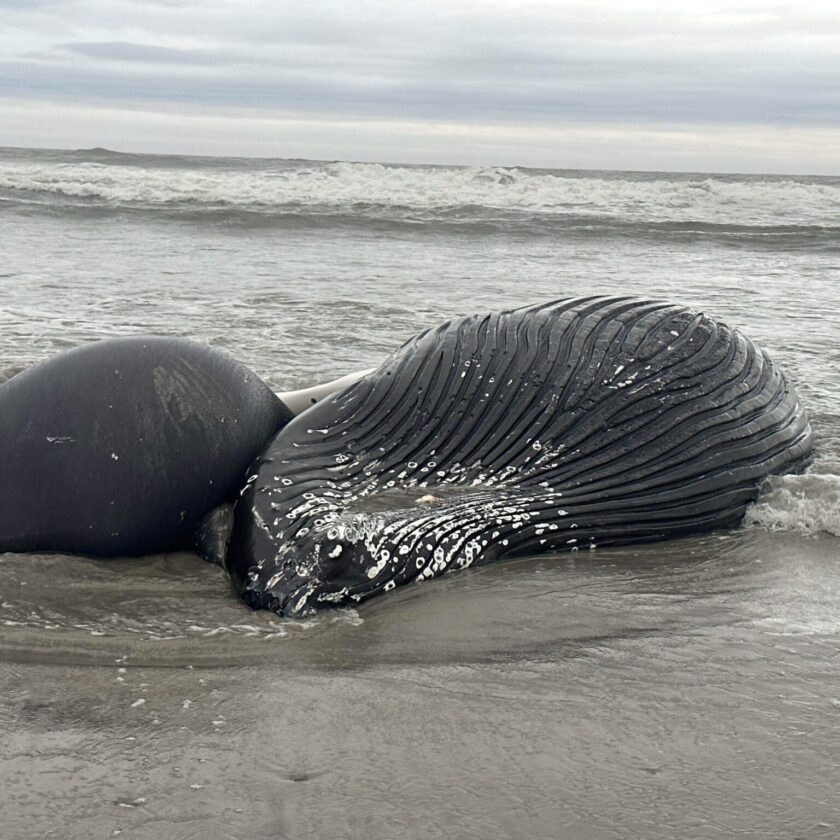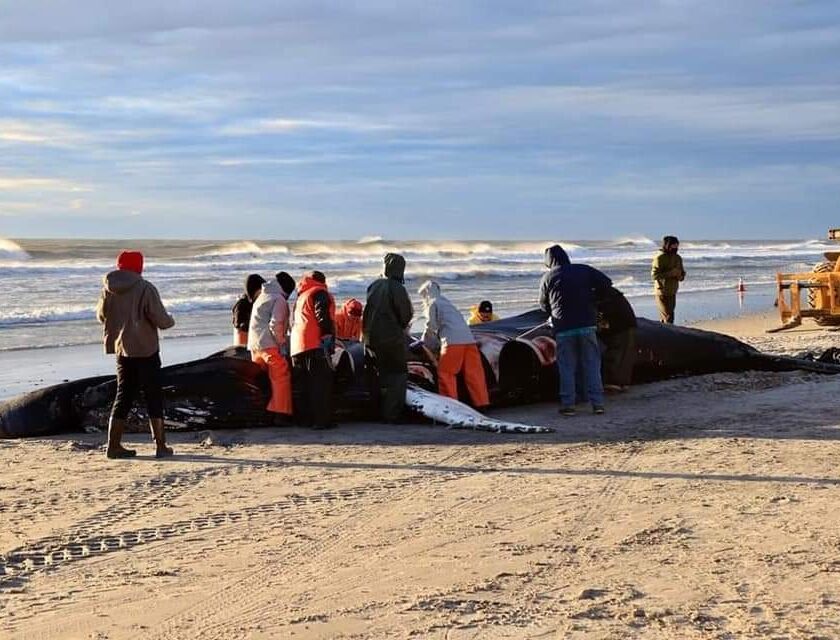By Sarah Fertsch
Staff Writer
A seventh whale has washed up on Jersey Shore and New York beaches in a little more than a month, and people want to know what’s going on.
On Jan. 12, a humpback whale washed up on the north end of Brigantine, found upside down in the surf during low tide.
On Jan. 7, a 30-foot juvenile humpback came to rest on the beach by the Tropicana Hotel and Casino in Atlantic City.
On Dec. 23, a dead juvenile humpback beached at Chelsea Avenue in Atlantic City.
The run of recent mortalities began Dec. 5 in Monmouth County and has included locations in Strathmere, North Wildwood and New York.
“It’s tragic,” said Delilah Morgan while walking along the beach in Atlantic City with her 4-year-old grandson Marcus. “These creatures are so majestic and we are so lucky to live by the same waters in which they thrive. But I guess they aren’t thriving at the moment.”
The question on everyone’s minds is why is this happening? What’s killing the whales?
According to National Geographic, whales beach themselves because of sickness or injury, which usually leads to a navigational error such as feeding too close to the shore. Sometimes old age is the simple culprit.
On some occasions, whales beach because they are pushed out of their environment due to pollution or overfishing. Locals suspect that sonar testing being done by Orsted, the developer contracted to build two offshore wind farms 15 miles out at sea, may be responsible for the marine mammal deaths.
On a Shore Local News Facebook post about the whales, folks were quick to blame Orsted.
“This is an opportunity to sue and stop the wind projects for a few months until federal action is taken,” Jay Samson said.
Elizabeth Ann wrote, “I conducted research on fishing gear entanglements/ghost gear in the state of New Jersey. You’d be surprised how prevalent this issue is within the state. Nevertheless, plastic ingestion and boat strike injuries are also a major cause of whale mortality. It doesn’t appear that this whale had any visible injuries (I don’t believe the others did either), so sound pollution could also very well be a plausible factor in these recent stranding events. It’s so awful that this is happening so often.”
Environmental groups called for a federal investigation into the whale deaths during a news conference Jan. 9 in Atlantic City on the beach where a female humpback whale was discovered. It was the second whale to wash up on the beach in Atlantic City within two weeks.

Photo by Connie Pyatt
Clean Ocean Action and Protect Our Coast NJ expressed fear and grief over the marine mammal deaths and asked for greater regulation over the offshore wind projects.
Politicians are also getting involved. U.S. Rep. Jeff Van Drew released a statement asking for all offshore wind activity to stop “following an unprecedented number of whales that have washed ashore in the New Jersey/New York area over the past month.”
“Since offshore wind projects were being proposed by Governor Murphy to be built off the coast of New Jersey, I have been adamantly opposed to any activity moving forward until research disclosed the impacts these projects would have on our environment and the impacts on the fishing industry,” Van Drew wrote.
The Republican representative for Atlantic and Cape May counties added:
“Ocean life is being put at risk as our governor and president force through their Green New Deal policies, without giving full consideration to their real-world impacts.”
State Sen. Vince Polistina, a Republican who represents Atlantic County including Brigantine, Atlantic City, and other beach towns, also released a statement:
“We should suspend all work related to offshore wind development until we can determine the cause of death of these whales, some of which are endangered. The work related to offshore wind projects is the primary difference in our waters, and it’s hard to believe that the death of (the) whales on our beaches is just a coincidence.”
The Marine Mammal Stranding Center based in Brigantine, which has been working to determine the causes of death and remove the carcasses from the beaches, released the following statement on the Jan. 12 case:
“The whale was a female, 32 feet 7 inches long, estimated to weigh about 12 tons,” MMSC posted on Facebook Sunday Jan. 15. “Preliminary results based on observations during the necropsy suggest that the whale suffered blunt trauma injuries consistent with those from a vessel strike.”
A necropsy of the Jan. 7 whale concluded that the juvenile female humpback was also struck by a boat.
“Although there has been speculation about whether these whale deaths are linked to wind energy development, at this point no whale mortality has been attributed to offshore wind activities,” MMSC posted. “We will continue to gather data and go where the science leads us.”
The post said there is a high number of large whales in the waters off New Jersey, likely attracted by small fish.
“We advise boaters to go slowly (less than 10 knots) and keep a lookout for whales.”
There is a voluntary slow zone in effect for the waters off New York and New Jersey, MMSC noted. There are also active Seasonal Management Areas where all vessels 65 feet or longer must travel at 10 knots or less, off the ports of New York, New Jersey and Delaware Bay.
Sheila Dean, director of the Marine Mammal Stranding Center, told locals not to be concerned, as some years naturally result in more beached whales than others.
Brigantine Mayor Vince Sera also issued a statement in response to the whale found on his island and the other beached whales. “We are heartbroken over the latest whale to wash ashore this morning in Brigantine,” Sera said.
The Marine Mammal Stranding Center concluded that the Brigantine whale, like its predecessor beached in Atlantic City, was likely struck by a boat. However complete neocropsy results of tissue and other samples will take several months.

The other whale mortalities included a 30-foot sperm whale on New York’s Rockaway Beach Dec. 12; a 20-ton, 30-foot humpback whale in the Strathmere section of Upper Township on Dec. 10, and a 31-foot humpback found dead on Indian Wells Beach in Amagansett, N.Y. Dec. 6.
The recent run of whale moralities started Dec. 5 when a 12-foot sperm whale beached in Keansburg, Monmouth County.
The Marine Mammal Stranding Center urges folks to maintain a safe distance from all stranded whales, mammals or turtles and to report all stranded marine mammals or sea turtles to the Marine Mammal Stranding Center immediately by calling the center’s 24 hour hotline at (609) 266-0538.
Sarah Fertsch was born and raised in Egg Harbor Township, and holds a dual degree in public relations and political science. Prior to joining Shore Local full-time, she worked at a CSPAN affiliate, writing about Pennsylvania legislation. When she isn’t writing, Sarah enjoys painting, horseback riding, and Crossfit.
















